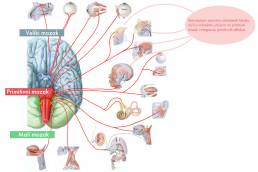Facial reflexes affect not only the function of facial structures, but also participate in the development of the entire body.
By integrating facial reflexes, we influence the development of movements needed for:
- feeding – sucking, chewing, swallowing, keeping food in the mouth, vomiting
- visual, olfactory and taste discrimination of food
- eye function – focusing, binocular vision, closing and opening eyes in sudden situations
- emotional expression
- coordination of mouth-hand movements; hand-mouth; eye-hand-mouth; tongue and lip movements
- coordination of mouth-hand movements; hand-mouth; eye-hand-mouth; tongue and lip movements

The picture shows the so-called cranial nerves, i.e. the nerves that innervate our head to the greatest extent.
There are 12 of them in total. They start right in the medulla oblongata, which has already been mentioned several times when we talk about primitive reflexes. By treating precisely determined regions of the face and head, we essentially treat the cranial nerves and by doing that we treat the primitive brain (extended medulla) when we indirectly integrate primitive reflexes and influence better speech, vision, hearing etc.